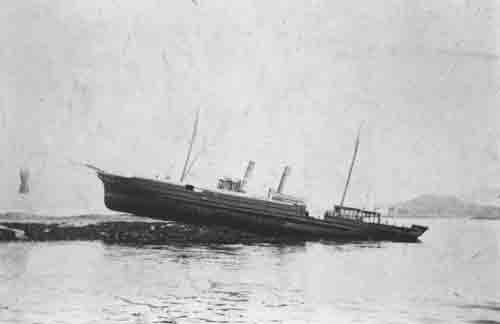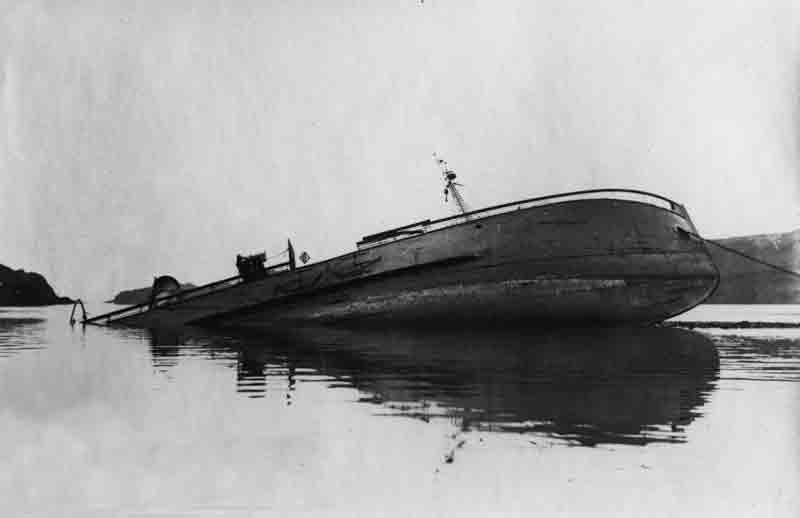This vessel was originally built as the Cardiganshire by Workman Clark and Co ltd., Belfast (Yard No 324) and launched on 30 September 1913. She was a steel steamship powered by twin triple expansion steam engines of 977nhp. Her dimensions were 500.3′ x 62.4′ x 42.6′ and she had a gross tonnage of 11,936t.
The large Cardiganshire was built for the Royal Mail Steamship Co Ltd of Belfast. She operated on the Far East route and was, at the time, the biggest and fastest vessel operating this service. At the start of World War One she was requisitioned by the Admiralty to be used as a troopship. She successfully completed a number of Transatlantic voyages bringing American troops to the conflict in Europe and participated in the Dardanelles campaign. After the war she returned to her normal service before she was sold to Christian Salvesen Company who renamed her Salvestria after the company’s founder. She was converted to a whaling factory ship working for Salvesen‘s South Georgia Company in the Falklands.
With the outbreak of World War Two in Europe she was again exposed to the dangers of seafaring during global conflict but was not to survive this second war. In the summer of 1940, the ship was en route from her South Atlantic base to the UK with a cargo of whale oil. She was under the command of Captain James C Jamieson and had a crew of 57 men. After a brief stop at Aruba from 14th to 16th June they proceeded to Bermuda arriving on 21st June. Here they joined convoy SL28 with 20 other merchant ships and 4 escort vessels heading east to Liverpool. They departed from Bermuda on 10th July and the Transatlantic voyage went well with no incidents. As they reached the Western Approaches, the convoy began to disperse to the ships’ various UK destinations. The Salvestria turned north to pass through the Pentland Firth and down the Scottish east coast to her own destination at Grangemouth.
She reached the Forth and was approached by the examination boat off Methil. At this point the Captain was instructed to move into Largo Bay and anchor to await a pilot to take her up river towards Grangemouth. After a few hours at anchor the pilot, Thomas Flockart, boarded the Salvestria and took command. They weighed anchor and steamed out into the channel joining a number of other ships steaming in line up the narrow safe channel through the British minefield guarding the entrance to the Forth Naval base. The centre of the safe channel was clearly marked by white danbuoys used to guide the ships through the danger. The tide was flooding, although only at an estimated one and a quarter knots, the effect continually pushed the ships away from the centre line of the channel. However, this was nothing new for Pilot Flockhart but accurately positioning this large ship, with a draught of nearly thirty feet, in the narrow channel was no easy task.
The exact cause of what happened next was never precisely determined by the subsequent enquiry but, at approximately 6.55pm, as the ship made the final turn to approach the gate ships of the boom guarding the entrance to the port, she was rocked by a large explosion near hold seven or eight. There was no column of water resulting from the explosion which was reported to be a heavy rumbling explosion from directly under the ship. The Salvestria immediately began to settle by the stern which quickly hit bottom in the relatively shallow water causing the ship to lurch to port. As the bow settled the ship returned to an even keel sitting on the seabed with her decks clear of the surface. The men who had survived the blast were all safely taken off the ship. Ten of the crew were killed by the explosion.
The enquiry focussed on a number of key features of the incident. It was unable to establish the precise position of the ship when the explosion occurred, but she now lay on the north side of the channel. The functioning of the degaussing cable fitted to the ship was investigated but no significant issues were discovered. The previous clearing of the channel by minesweepers was also closely examined but again no concerns were raised. In the end, while inconclusive, the enquiry determined the explosion was likely the result of the Salvestria being slightly north of her intended position and therefore colliding with one of the mines guarding the channel.
The wreck of the Salvestria, which lay slightly north of the swept channel, remained untouched during the remainder of the war but was then the subject of multiple salvage efforts. The engines and condensers were removed almost immediately after the war by Whites of Burntisland and later salvors gradually reduced the wreck to what remains today. The site, in position 56°04.046’N, 003°04.870’W, is now a mass of tangled broken steelwork with little recognisable remaining. At the highest point the wreck rises 4 metres from the muddy seabed. Visibility in this section of the Forth is generally 2 metres or less.






























